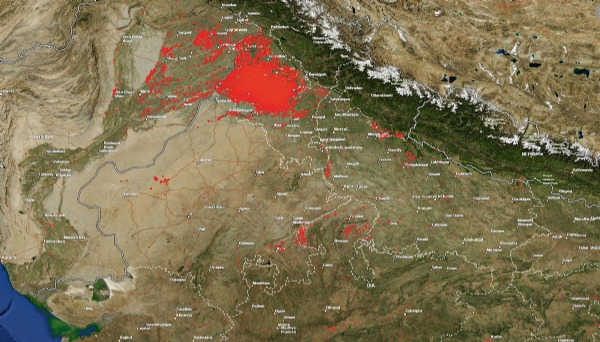No, it is not Diwali! NASA release its report on Delhi pollution, says 'stubble burning is real cause'
While total fire counts have remained consistently high in Punjab, satellite data indicates that campaigns to get farmers to clear fields without using fire have proven more successful in Haryana.
Total Views |
New Delhi, November 19: At a time when India's national capital is witnessing soaring levels of air pollution, the American space agency, NASA, highlighted that stubble burning in the states of Punjab and Haryana had led to a sharp deterioration of air quality in northwestern India. It also pointed out that fires in northern Pakistan likely contributed to some of the smoke as well.

In its report, NASA said, "On November 11, 2021, the Visible Infrared Imaging Radiometer Suite (VIIRS) on the Suomi NPP satellite acquired this natural-color image of a river of smoke streaming from fires in Punjab and Haryana toward Delhi, one of India’s most populous cities."
Analysing the report, Pawan Gupta, a Universities Space Research Association (USRA) scientist at NASA’s Marshall Space Flight Center, said that at least 22 million people were affected by smoke produced due to stubble burning on November 11 alone.
He said, "Looking at the size of the plume on November 11 and the population density in this area, I would say that a conservative estimate is that at least 22 million people were affected by smoke on this one day."
It also pointed out that smoke from crop fires is not the only contributor to the hazy skies. Influxes of dust sometimes arrive from the Thar Desert to the west—as they did on November 12, 2021 (see image below). An array of other human-caused sources of air pollution in cities, including motor vehicle fumes, industrial and construction activity, fireworks, and fires for heating and cooking, also produce particulate matter and other pollutants.
According to the Fire Information for Resource Management System of NASA, the incidents of fires in Punjab and Haryana have gone up significantly in October, with it reaching its peak in the last week.
Due to wind direction, the smoke from the stubble burning in Punjab and Haryana moves towards Delhi, where it remains stationary due to the lack of wind movement in the region. Fog caused by lower temperatures captures the pollutants in the air and keeps them suspended in the air for a longer time, which creates toxic smog.
While total fire counts have remained consistently high in Punjab, satellite data indicates that campaigns to get farmers to clear fields without using fire have proven more successful in Haryana. By November 16, the Visible Infrared Imaging Radiometer Suite (VIIRS) sensor detected over 74000 hotspots in Punjab. The number is closer to the 85000 hotspots that were detected by the sensor in 2016.
"Over nine years of VIIRS observation, we don’t see much of a trend in Punjab. However, in Haryana, we saw a 45 percent decrease in the total number of fires in 2020 compared to the 2012-2019 average," Gupta added. "But fire counts seem to be on the higher end in Haryana again this year."
.
.